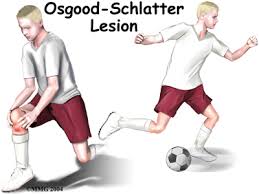
Osgood-Schlatter disease is a common cause of knee pain in growing adolescents. It is an inflammation of the area just below the knee where the tendon from the kneecap (patellar tendon) attaches to the shinbone (tibia).
Osgood-Schlatter disease most often occurs during growth spurts, when bones, muscles, tendons, and other structures are changing rapidly. Because physical activity puts additional stress on bones and muscles, children who participate in athletics — especially running and jumping sports - are at an increased risk for this condition. However, less active adolescents may also experience this problem.
In most cases of Osgood-Schlatter disease, simple measures like rest, over-the-counter medication, and stretching and strengthening exercises will relieve pain and allow a return to daily activities.
The bones of children and adolescents possess a special area where the bone is growing called the growth plate. Growth plates are areas of cartilage located near the ends of bones. When a child is fully grown, the growth plates harden into solid bone.
Some growth plates serve as attachment sites for tendons, the strong tissues that connect muscles to bones. A bony bump called the tibial tubercle covers the growth plate at the end of the tibia. The group of muscles in the front of the thigh (called the quadriceps) attaches to the tibial tubercle.
When a child is active, the quadriceps muscles pull on the patellar tendon which in turn, pulls on the tibial tubercle. In some children, this repetitive traction on the tubercle leads to inflammation of the growth plate. The prominence, or bump, of the tibial tubercle may become very pronounced.
Symptoms
Painful symptoms are often brought on by running, jumping, and other sports-related activities. In some cases, both knees have symptoms, although one knee may be worse than the other.
• Knee pain and tenderness at the tibial tubercle
• Swelling at the tibial tubercle
Tight muscles in the front or back of the thigh
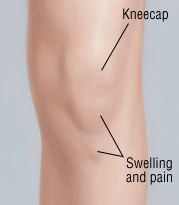
Risk Factors
The main risk factors for Osgood-Schlatter disease are:
• Age. Osgood-Schlatter disease occurs during puberty's growth spurts. Age ranges differ by sex because girls experience puberty earlier than do boys. Osgood-Schlatter disease typically occurs in boys ages 13 to 14 and girls ages 11 to 12.
• Sex. Osgood-Schlatter disease is more common in boys, but the gender gap is narrowing as more girls become involved with sports.
• Sports. The condition happens most often with sports that involve a lot of running, jumping and swift changes in direction
Doctor Examination
During the appointment, your doctor will discuss your child's symptoms and general health. He or she will conduct a thorough examination of the knee to determine the cause of the pain. This will include applying pressure to the tibial tubercle, which should be tender or painful for a child with Osgood-Schlatter disease. In addition, your doctor may also ask your child to walk, run, jump, or kneel to see if the movements bring on painful symptoms.
Your doctor may also order an x-ray image of your child's knee to help confirm the diagnosis or rule out any other problems.
Treatment
Treatment for Osgood-Schlatter disease focuses on reducing pain and swelling. This typically requires limiting exercise activity until your child can enjoy activity without discomfort or significant pain afterwards. In some cases, rest from activity is required for several months, followed by a strength conditioning program. However, if your child does not have a large amount of pain or a limp, participation in sports may be safe to continue.
Your doctor may recommend additional treatment methods, including:
• Stretching exercises. Stretches for the front and back of the thigh (quadriceps and hamstring muscles) may help relieve pain and prevent the disease from returning.
Strengthening Exercises
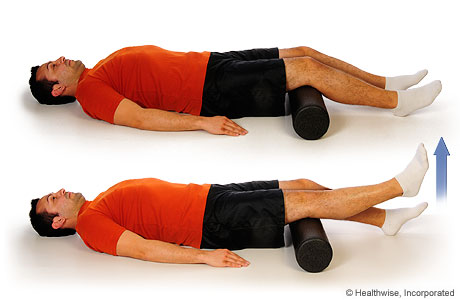
1. Lie on your back with your knees bent over a foam roll or large rolled-up towel and your heels on the floor.
2. Lift the lower part of your affected leg until your leg is straight. Keep the back of your knee on the foam roll or towel.
3. Hold your leg straight for about 6 seconds, then slowly bend your knee and lower your heel back to the floor. Rest for up to 10 seconds between repetitions.
4. Repeat 8 to 12 times.
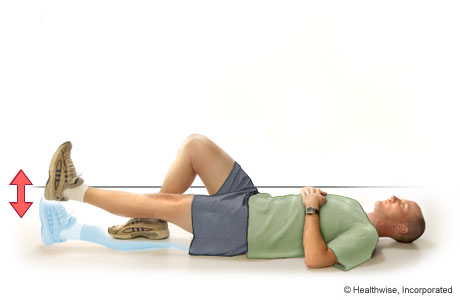
• Keeping the thigh muscles tight and your leg straight, lift your leg up so that your heel is about 30 cm (12 in.) off the floor.
• Hold for about 6 seconds, then lower your leg slowly. Rest for up to 10 seconds between repetitions.
• Repeat 8 to 12 times.
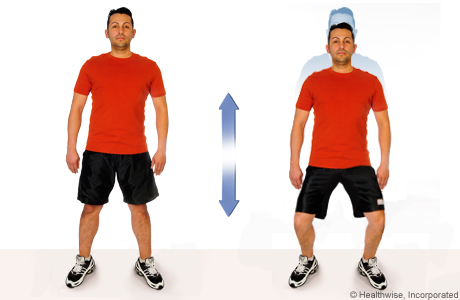
1. Stand with your feet about shoulder-width apart and turned out to the sides about 45 degrees.
2. Keep your back straight, and tighten your buttocks.
3. Slowly bend your knees to lower your body about one-quarter of the way down toward the floor. Do not let your knees extend beyond the tip of your toes, and keep your heels on the floor.
4. Repeat 8 to 12 times.
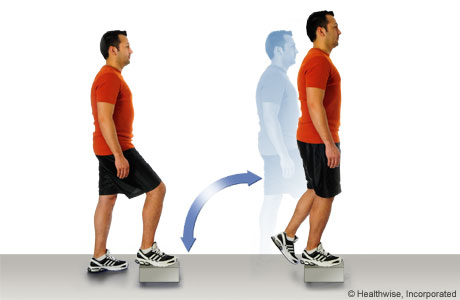
1. Place a single-step footstool on the floor. If you do not have a footstool, you can use a thick book, such as a phone book, a dictionary, or an encyclopedia. If you are not steady on your feet, hold on to a chair, counter, or wall while you do this exercise.
2. Keeping your back straight, step up with your affected leg. Try not to push off your back leg as you step up. Only use your affected leg to bring you up on to the step. Then lift your other leg on to the step. As you step up, try to keep your knee moving in a straight line with your middle toe.
3. Move back to the starting position, with both feet on the floor.
4. Repeat 8 to 12 times.

1. Stand on a single-step footstool. If you do not have a footstool, you can use a thick book, such as a phone book, a dictionary, or an encyclopedia. If you are not steady on your feet, hold on to a chair, counter, or wall while you do this exercise.
2. Slowly step down with your good leg, allowing your heel to lightly touch the floor. As you step down, try to keep your affected knee moving in a straight line toward your middle toe.
3. Move back to the starting position, with both feet on the footstool or book.
4. Repeat 8 to 12 times.
• Non-steroidal anti-inflammatory medication. Drugs like ibuprofen and naproxen reduce pain and swelling.
Other treatments
• Rest the joint. Limit the time spent doing activities that aggravate the condition, such as kneeling, jumping and running.
• Ice the affected area. This can help with pain and swelling.
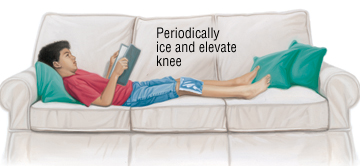
• Protect the knee. When your child is participating in sports, have him or her wear a pad over the affected knee at the point where the knee may become irritated.
• Try a strap. A patellar tendon strap fits around the leg just below the kneecap. It can help to "tack down" the kneecap's tendon during activities and distribute some of the force away from the shinbone.
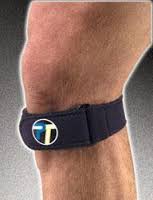
• Cross-train. Suggest that your child switch to activities that don't involve jumping or running, such as cycling or swimming, until symptoms subside.

Outcome
Most symptoms will completely disappear when a child completes the adolescent growth spurt, around age 14 for girls and age 16 for boys. For this reason, surgery is rarely recommended. However, the prominence of the tubercle will persist.